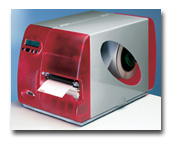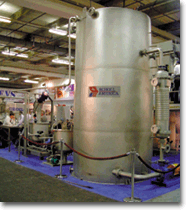
Finishing First
ATME-I 2001 showcased dyeing, printing, and finishing technologies.
ATME-I 2001, held April 23-27 at Palmetto Expo Center in Greenville,
S.C., featured weaving and knitting technology, as well as equipment for dyeing, printing,
finishing and support services. In this report,
Textile Industries Technical Editors Dr. Peter Hauser and Dr. Gary Mock review the dyeing,
printing and finishing segment of the show, with assistance from Senior Technical Editor Eric
Vonwiller. In August, Vonwiller will profile weaving technology, and Executive Editor Jim Phillips
will report on developments in knitting machinery presented at ATME-I. Digital PrintingDigital
printing was the highlight of the wet-processing portion of the ATME-I show in Greenville. Three
important vendors emphasized different aspects in their offerings:The DuPont Artistri Color
ControlandManagement System with the Ink Jet 3210 digital printing machine was first introduced at
Heimtextil 2001, held in Frankfurt, Germany, in January. Marco Torri, European sales manager and
John Kane, textile product marketing manager, said Artistri incorporates a unique colorant system,
printer, and software. Artistri represents a remarkable re-entry into textiles and colorants for
DuPont, which left the textile dye business in 1980. The 3210 prints 3.2-meter-width fabrics
roll-to-roll in eight colors: CYMK, light C, light M, Orange, and Green at 30 to 60 square meters
per hour (m2/hr). The current version will print pigment inks and binder, which dry and cure as
they exit the machine. DuPont claims to be the first production-capable textile printer. The
company aims this machine at the home furnishings market this year and looks to apparel with other
dye systems at the end of the year.Another pioneer, the Netherlands-based Stork, which first
introduced ink-jet printing at ITMA 1991 in Hannover, Germany, showed three printers. Ed Fesmire,
sales manager of digital printing products in Storks Charlotte, N.C., office; and Lo Boelhouwers,
manager of exhibitions, conferences and events, explained that the Amber is the oldest and most
versatile of the current line. It prints 2 m2/hr using six inks: (CYMK plus) cyan, light cyan,
magenta, light magenta, yellow, and black. Amber is capable of printing reactive and acid dyes.The
new Zircon II printer, capable of 1.55-meter printing, was introduced at ATME-I 2001 and will print
short-run disperse-dye polyester production printing at 10 m2/hr. The intended market is flags,
banners, backdrops and fashion.The Amethyst prints roll-to-roll 1.6-meter-width goods with six
reactive colors, CYMK times two, at a print speed of up to 16 m2/hr in high-speed mode. It is
designed to be set up and run all night without supervision. The model at the show was to be
shipped to the Springs Industries Design Center. Springs has used earlier Stork digital printers to
print one-of-a kind samples for market presentation.
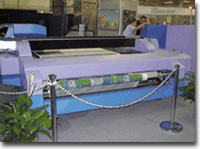
Austria-based J. Zimmer Maschinenbau GmbH, a pioneer in ink-jet
printing for carpet, introduced Chromotex, a true-color printer capable of roll-to-roll printing of
2.2-meter-width goods in eight colors with a resolution equal to 125-mesh rotary screen printing.
The emphasis is on small production runs. Hannes Fischer, manager, digital printing systems,
explained that the companys choice of 80-micron-diameter nozzles and constantly circulating ink
supply gives Zimmer the capability of printing 125-mesh resolution, an industry standard, with
virtually no clogging. Indeed, this machine was shut down totally for a two-week Christmas holiday
and restarted in mid-January with no problems. Print speed is given as 30 m2/hr in four-color mode
and 15 m2/hr in eight-color mode. Pigments with binders included in the supply, as well as disperse
and reactive dyes available from a choice of vendors, were felt to be strong points for seamless
integration of this printer with production rotary screen machines. DyStar, Ciba, BASF and others
have been involved in this project. Refillable tanks enable flexible operation. The print head is
positioned some 60 millimeters (mm) above the moving apron, allowing flat goods and pile-fabric
printing. It also minimizes clogging of the nozzles from any fabric dust or other contaminants.
Penetration was shown to be excellent for a plush fabric.Spectrophotometry And Color
ManagementColor measurement and management are the keystones in a successful apparel or home
furnishings business. With increasing globalization, accurate color communication is
imperative.Datacolor, Lawrenceville, N.J., and Dietlikon, Switzerland, showed a new portable
product, the Mercury Color Management System. The Mercury has a one-piece tower configuration for
one-handed operation with a customized Personal Data Assistant that uses the Palm operating system.
The 9.7-centimeter (cm) by 9.5-cm by 24.6-cm unit weighs only 1 kilogram (kg), so it can easily be
carried from one textile sample to the next. A dual-beam sphere with automatic specular port and a
pulsed xenon light source allows rapid measurement. The touch-screen display puts the user in touch
with up to 30,000 sample measurements using CIELAB and nine selectable illuminants. Color data can
be captured anywhere and communicated later through an RS 232 data port.GretagMacbeth LLC, New
Windsor, N.Y., and Regensdorf, Switzerland, introduced NetProfiler for color measurement instrument
certification. NetProfiler tests, measures, and profiles color measurement instruments anywhere in
the world using the open architecture philosophy of the Internet. Now, remote instruments from
different vendors can be calibrated and certified on-line.Another product introduction was Net
Palette, the first Internet-based supply chain tool for color communication to allow paperless
color approval.Instantaneous exchange of color palettes over the Internet enables dyehouses to
match design specifications, electronically submit lab dips, receive color approval via the
Internet and obtain production approval. These two products can offer a great deal of comfort and
satisfaction to managers who source worldwide.Also, GretagMacbeth announced a strategic alliance
with color formulation software developer SheLyn Inc., Greensboro, N.C., to integrate its SLI-Form
software with the NetProfiler. In addition, San Francisco-based Freeborders.com, a leading provider
of Collaborative Product Management solutions for global retail, announced it would integrate Net
Palette into its supply-chain solution for the textile and apparel industries. Many suppliers have
large investments in so-called color legacy systems. GretagMacbeths open architecture solution
allows various vendors to communicate seamlessly without reworking all their historical data and
changing the data for various customers. More than 250 customers located in 26 countries and
including Liz Claiborne, Levi-Strauss Inc. Nike, L.L. Bean, Lands End and Dillards use
Freeborders.com solutions.HunterLab, Reston, Va., showed its portable spectrophotometer, the Lab
Scan XE, which measures color the way the eye sees color. A built-in pass/fail quality-control
system allows easy shade sorting. A series of sensitive khaki swatches was measured and sorted
using the She-Lyn SLI-Taper software system. Other products shown were the new Color Quest XT, a
self-contained spectrophotometer designed to measure transmitted color of transparent materials and
generate ADMI values of waste water containing dyestuffs and textile effluents. Also exhibited was
a new version of the Easy Match Textiles color formulation software. One of the many additions and
modifications is the ability to show only those colorants that can match a requested setup type.
This feature makes switching between dye classes much easier for blend formulations and allows
users to perform formulations without the risk of mixing incompatible dye classes and process
types. This software is also available as an upgrade to existing systems.At Mahlo, Spartanburg,
S.C., and Saal-Donau, Germany the worlds leading specialist in monitoring and control systems for
the textile, nonwoven, plastics, and paper industries the focus was on the small, hand-held
Color-Guide spectrophotometer. More than 6,000 Color-Guides are in use worldwide. This instrument
incorporates patented LED technology to deliver unsurpassed accuracy and stability in a portable
instrument. Several new LEDs have extended the range of illuminants available in the latest model.
The Color-Guide can take up to 10,000 measurements per battery charge and requires standardization
only once every 90 days. Data is downloaded to a PC via the RS 232 interface. Mahlo also showed a
number of fixed-base spectrophotometers and software provided by SheLyns SLI-Form NG/QC package and
industrial online color measurement provided by the Colorscan CIS-10 traversing reflectance
spectrophotometer.Dry/Wet Processing, Washing, TestingAmerican Monforts Corp., Charlotte, N.C.,
presented several new developments for drying fabrics. The Montex 5000 tenter frame has been
outfitted with stronger chains, clips, and rails for more reliable operation at higher operating
speeds. The new Dynair 5000 relaxation dryer allows knit goods to uniformly relax in all directions
while being transported through the dryer on a pulsed air flow.Argelich, Termes y Cia. S.A. (ATYC),
Spain, displayed a new Rapid System jet-dyeing machine that incorporates quick filling, draining,
and rinsing features to reduce dyeing cycle times. Liquor ratios as low as 4:1 are possible.Babcock
Textile Machinery (BTM), Pineville, N.C., exhibited the new tenter generation Babco-Star
incorporating the new energy-efficient sealed oven. This tenter features no loop chain and is
capable of running up to 250 yards per minute (yd/min). Krantz, a member of the BTM group, showed
its new Shear Cut Batcher that permits tensionless cutting and features a mandrelless automatic
fabric winder. The Krantz Syncro Double is a double-layer shrink dryer for knitted and woven
fabrics and has a Siemens computer system with decentralized control logic. It features moisture
control and emissions control, and permits up to 200 percent over-feed. At Loris Bellini S.p.A.,
Italy, the focus continues to be on yarn dyeing. The Autolabo, a laboratory machine for dyeing yarn
packages, is the companys latest offering. This machine was designed to reproduce exactly the
dyeing conditions in Bellinis production dyeing machines and includes computer-controlled dye and
chemical additions. As a result, shades dyed in the Autolabo can be replicated exactly in
production. From 1 to 3 yarn packages can be dyed at a liquor ratio of 8:1.

The U.S. market is important to Biancalani S.p.A., Italy. Its Petra
machine was developed with the American market in mind. Petra was first shown at ITMA 1999 in
Paris, but since then, it has been made more reliable and shows higher productivity over the
earlier version. This machine produces color reduction and abrasion effects on full-width denim
fabric at 10 meters/minute (m/min) by a series of abrasive cylinders combined with water. Fabric
comes off the Petra ready for compressive shrinkage. Garments made from fabrics processed on the
Petra require only one-third the usual amount of time to be finished. The line of Italy-based
Bianco S.p.A. equipment has been supplemented with a new-width monitor and controller for use with
tenter frames. In addition, a new rope opener and slitter has been developed that minimizes
changeover time from one style to another.Italy-based Brazzoli S.p.A. exhibited its latest
generation of dyeing machinery. The Saturno Lux, suitable for 100-percent cotton, cotton/Lycra® and
cotton/nylon fabrics has an overflow system that reduces the time of the dyeing process. Brazzoli
also featured the Sirio dyeing machine with Turbovario device, a variable bath passage
cross-section. As well, the company displayed the Orion horizontal dyeing machine. At the show,
company officials said Brazzoli has recently opened a new sales and service facility for the
Americas in Mooresville, N.C. It includes a showroom and a well-stocked parts department.The CIBI
Compactex, a new compacting machine shown by Cibitex S.r.l., Italy, processes woven and knitted
fabrics in a very space-efficient configuration.The new development at Italy-based Comet S.p.A.
(recently merged with Santalucia and now known as Unitech) is the PegasoX11, a machine that uses
silicon carbide brushes and/or sandpaper to soften fabrics without raising a noticeable pile.
Control features include adjustable contact areas and tensions. A wide variety of fabrics can be
processed at speeds of up to 15 m/min. The Pegaso-X11 was based on Comets successful and proven
napping technology.Corino Macchine S.r.l., Italy, has introduced a new laser-guided
slitter/detangler to improve productivity, along with a reengineered extraction pad with improved
safety features. A novel fabric plaiter on rails allows higher production speeds.Famas S.r.l.,
Italy, a member of the TEXBIMA consortium, produces satin and molleton wrapper fabrics for
decatizing wool and wool-blend fabrics for the clothing industry.A new transfer printing machine
designed for economically producing short runs and samples was shown by Gessner, Worcester, Mass.
The Transcolorizer II uses a microprocessor controlled temperature system that maintains less than
1°C temperature difference while providing rapid warm-up and longer heater life. Another new
development from Gessner is the Thermalbrush machine, which brushes and heat-stabilizes the pile
fibers of napped automotive fabric, providing a longer-lasting surface appearance.Three new
laboratory testing machines were introduced by United Kingdom-based James H. HealandCo. Ltd. The
Impulse is a random tumble pilling instrument designed for the U.S. market. Its independently
controlled modules and interchangeable impellers allow for compactness and versatility. User safety
is assured by interlocks that stop the machine instantly if the doors are opened while the
impellers are rotating. The TruBurst is a computer-controlled instrument for accurately determining
the burst strength of a variety of substrates including traditional textiles, nonwovens, paper, and
plastics. A special software package permits data analysis and report writing in five languages
(See New Products,
TI, this issue) A budget-priced 4-head abrasion and pilling tester, the Nu-Martindale, has
many of the features of the widely used 6-head tester, but with a cost designed for smaller
laboratories.Modular package-dyeing equipment by International Dyeing Equipment Inc., Stanley,
N.C., can easily be configured to dye differently sized loads with the same unit. The Windows
NT-based control system uses liquor flow rather than time to control the process. Continuous
monitoring of pH and salinity provides real-time data on the dyeing process.Kusters Textile
Machinery, Spartanburg, S.C., presented several innovations in the continuous washing of open-width
fabrics. A new vacuum-assisted washer was shown that can be used in preparation processes of woven
fabrics in combination with conventional wash boxes. Putting this vacuum washer as the last washer
before drying replaces 1 to 2 conventional wash boxes and can produce extremely clean fabrics at
production speeds of 150 to 200+ yd/min. The TurboFlush washer, shown at ITMA 1999, is widely
accepted as state-of-the-art technology and provides excellent reproducible washing results for
both pile and flat-woven fabrics with reduced water and energy consumption. Additional Kusters
offerings include a calender for thermobonding nonwovens with a heated engraved roll and a modified
dye-pad box with an insert to minimize the amount of pad liquor needed.Lawson-Hemphill Sales Inc.,
Spartanburg, S.C., exhibited its new high-speed production knitter that the company says is perfect
for sample preparation for use in the dyehouse or laboratory. The Basic Knitter is a 3 1/2-inch
knitting machine that features interchangeable cylinders for a wide range of yarn counts and yarn
types.The company, as well, exhibited a wide range of testing products, including equipment for
yarn analysis, quality control and laboratory testing.Germany-based Mageba Textilmaschinen, a
producer of machinery for processing narrow fabrics, showed a laboratory system for warping,
weaving, dyeing, and finishing these specialty fabrics. A new concept in jet dyeing was shown by
MCS, Italy. In the Multiflow® machine, single-fabric rope moves in a helical fashion through
multiple dyeing chambers, producing extremely level dyeings in 50 percent less time than in
conventional one-rope-per-chamber jet machines.Special tenter rails and clips from Marshall and
Williams, Greenville, S.C., allow the companys latest tenter frame to operate at production speeds
exceeding 300 yd/min. Improved air flow from direct-drive fans gives better temperature control.
The computerized control system automatically monitors and adjusts fabric width and tension.A new
portable spectrophotometer, the CM2600d, was introduced by Minolta Corp., Ramsey, N.J. The optical
system of this instrument is based on Minoltas successful bench- top spectrophotometers. A useful
feature is automatic adjustment for ultraviolet light.The True-Matic inspection frame shown by
Joseph Pernick Manufacturing Corp., Glendale, N.Y., is an improved version of an earlier model. In
addition to measuring relaxed fabric width and length, this computer-controlled system stores the
data automatically and can produce detailed reports for review.Santex AG, Switzerland, developed
its new SANTAbrUSH machine using its existing sueding machine as a model. The SANTAbrUSH can be
used with any fiber or fabric construction to soften and smooth surface appearance through the use
of adjustable brush rollers. The machine operates on open-width fabrics, maintains constant fabric
tension throughout the process, and incorporates a dust-removal system for worker safety. By
adjustment of the operating parameters, a variety of effects is possible. Santex also introduced a
new device to spread wet tubular knits without leaving permanent marks. The SANTAStrETCH uses only
one-tenth the force of competing spreaders due to its unique magnetic spreading assembly. Another
new machine by Santex, the SANTASPREAD TS, is designed as a high-speed compactor for tubular knits.
Improved felts and heated shoes, along with constant tension, provide a more reliable compaction
process. Technology from its partner SperottoRimar, Italy, has allowed Santex to develop the new
Decofast, a continuous decating machine.Scholl America Inc., Charlotte, N.C., showed its new
automated Century Intermix Dissolving System for powder bulk chemicals. The system is
computer-controlled and automatically prepares solutions with glaubersalt, common salt, and soda
ash. It allows automated dispensing and fast transfer into the dyeing process. Scholl also
exhibited the new Rapidstar MiniLab sample piece-dyeing machine that was designed to transfer all
important dye-setting data to the production machines for 100-percent repeatability and accuracy.
The new Rapidstar Century provides fast process cycles for a large variety of knitted and woven
fabrics and features a very low consumption of steam, water, energy, salt and chemicals. Its
patented Rapidflex variable chamber adjustment option offers high flexibility that accommodates
todays varying load sizes, fabric weights and fabric styles.
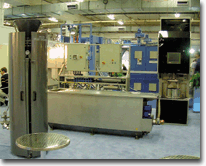
Sclavos, Greece, showed the improved version of the Robolab 240, an
automatic dispensing and solution preparation system. Sclavos claims the Robolab is totally
automated and extremely accurate with respect to color matching. Sclavos showed the prototype of
the automated dispensing system from Pozzi that will be used in conjunction with its machinery, and
displayed further the latest generation of its Venus dyeing machine.Superba S.A., France, showed
its latest version DL 5 dyeing line for space-dyeing effects, originally introduced at ITMA 1999 in
Paris. The line is made of stainless steel and features an on-line washing system. Drying capacity
is up to 400 kg/hr. Superba showed for the first time the improved dyeing head with deflector
plate. This allows the creation of special dye patterns in combination with the dye head.Thies
Corp., Rock Hill, S.C., presented a sample jet-dyeing machine designed to give excellent
correlation to production dyeings. Not present at the show, a recently patented development by a
Thies/Dystar collaboration, the Luft-roto plus jet-dyeing machine delivers 100-percent cotton
dyeings with very low liquor ratios (as low as 3.5:1), short process times, and extremely low
energy consumption. Dispensing Systems
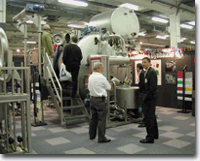
A number of companies exhibited dispensing systems. Several
companies that have been in the market for some time did not appear to make it to this show. This
is a mature technology, having been around for more than 20 years, with few innovations in
2001.Gaston County Dyeing Machine Co., Stanley, N.C., emphasized its new automatic chemical
dispensing system that is an important integrated module of the SuperTex dyeing system for most
efficient and quality oriented dyeing. SuperTex+SQL software provides control and supervision in
virtually every dyeing area and is the perfect match to Gaston Countys Millennium dyeing machine.
The Millennium itself was displayed with a space-saving horizontal charge tank and features now an
increased capacity from 400 pounds (lb) to 500 lb per chamber. Its Sentinel control system is a
profi-bus system with Internet capability for global customer service support.Technorama S.r.l.,
Italy, developed the first gravimetric dispensing systems, Dosarama, in 1986. The accuracy claimed
was ± 0.01 grams (g). The new laboratory Dosarama WS at the show is a combined dispensing system
for powder or granulated dyes with an accuracy of ±0.001 g using a Sartorious scale and a
volumetric multi-pipette system for liquids and solutions. With this machine, standard concentrated
solutions can be prepared for further dosage and automatic replacement of expired and exhausted
sample bottles. Larger industrial systems were not exhibited at ATME-I 2001.Another
well-established vendor of large dispensing systems is Lawer S.p.A., Italy. The Supercolor
industrial-scale dispensing system shown at ATME-I 2001 consisted of 20 silos, a
computer-controlled weigh trolley capable of moving at up to 6 meters per second and a Mettler
multi-range scale with capacity of 32 kg and a resolution of ±0.01 g. The control system is
Windows-based.Systems can be furnished in units of 10 silos, with one 120-silo installation
existing. Each silo has a clear front panel for visual monitoring of dye content. Each silo can be
individually removed for cleaning. A bar-code system on the backside assures refilling with correct
dye.A reliable dispensing system for liquid dyes and chemicals was shown by Termoelettronica,
S.p.A., Italy. The easy-to-use and -install system allows rapid dispensing by the use of air
pressure followed by water rinsing, while a touch-screen controlled microprocessor ensures
reproducibility.
June 2001







